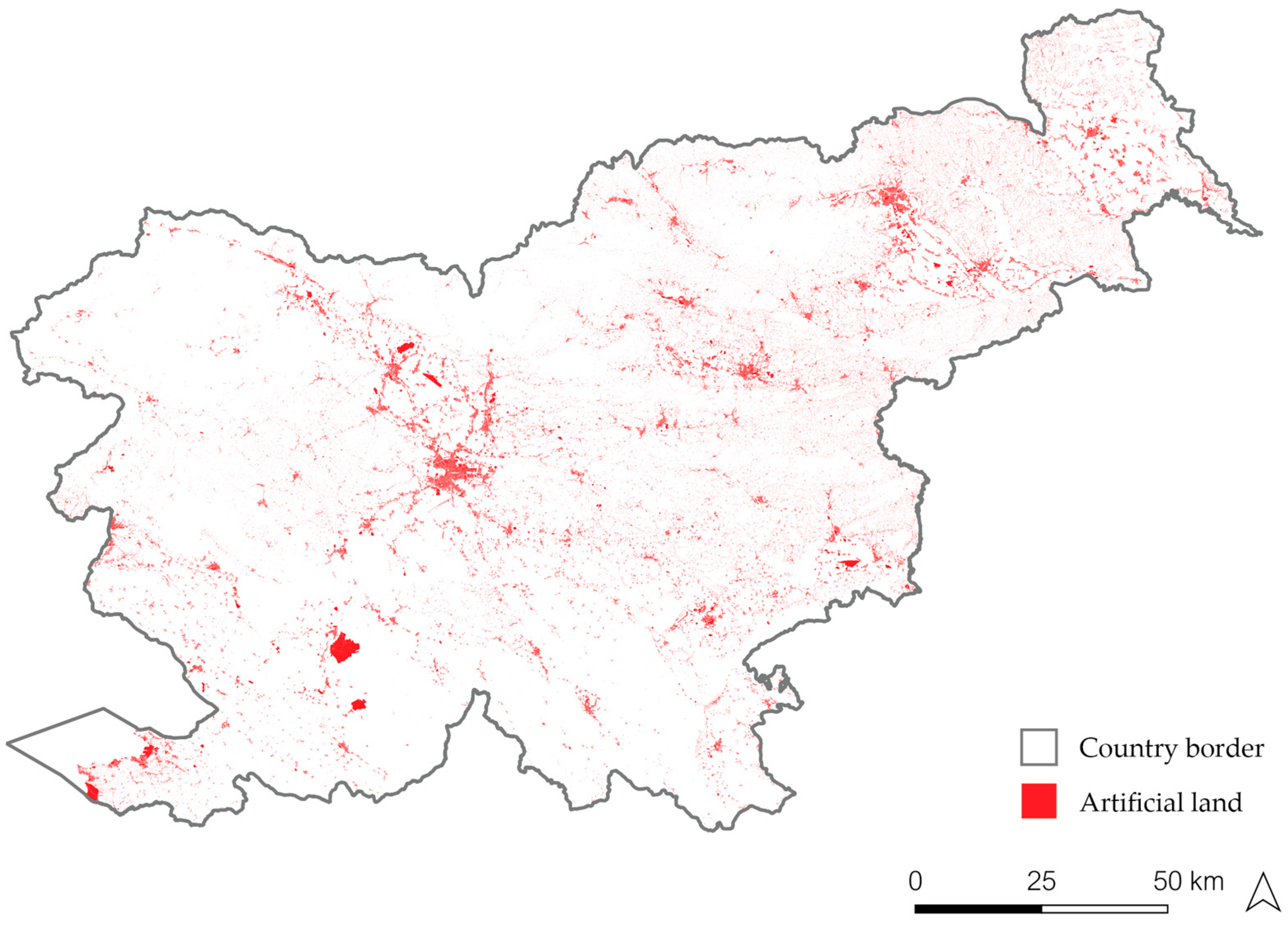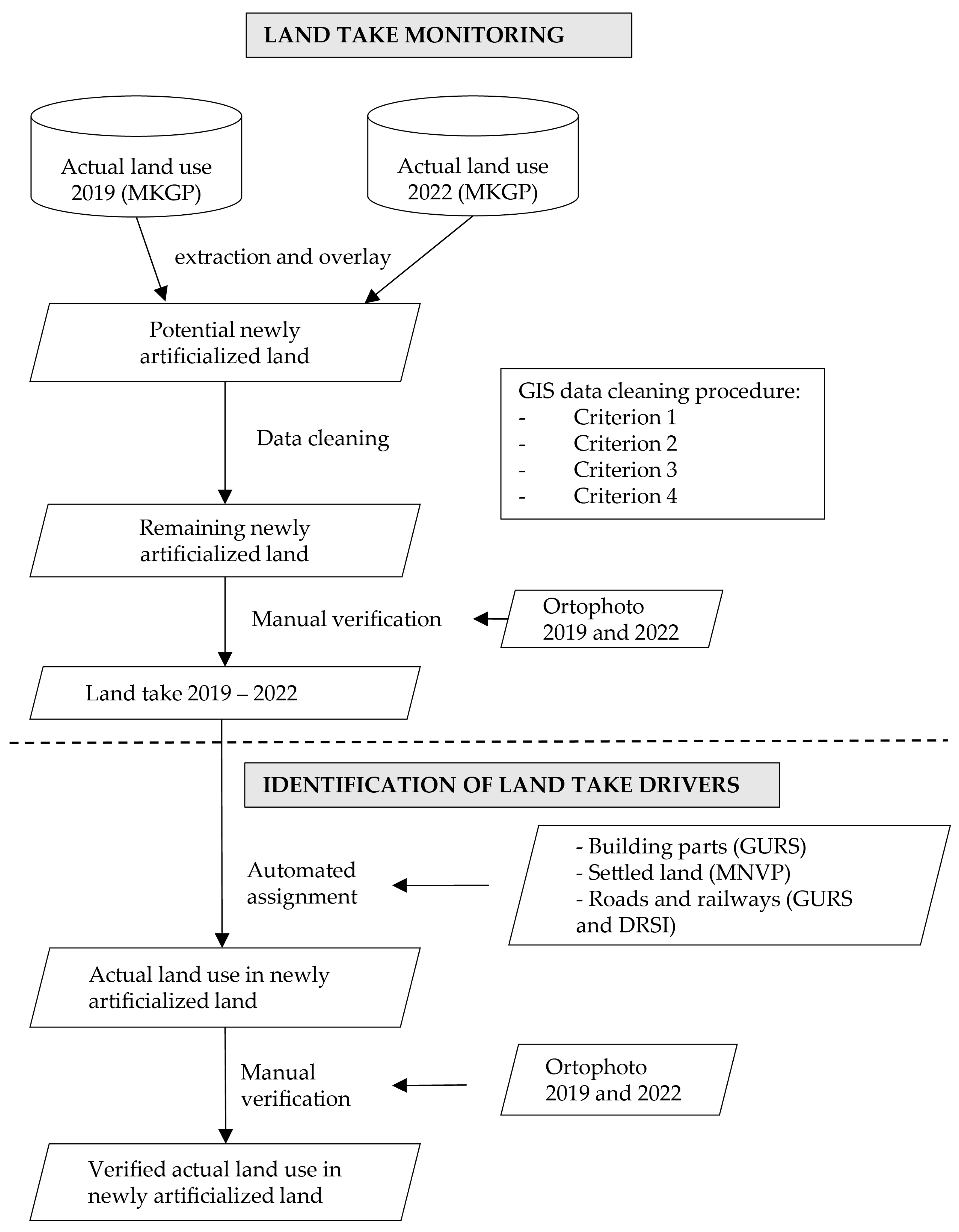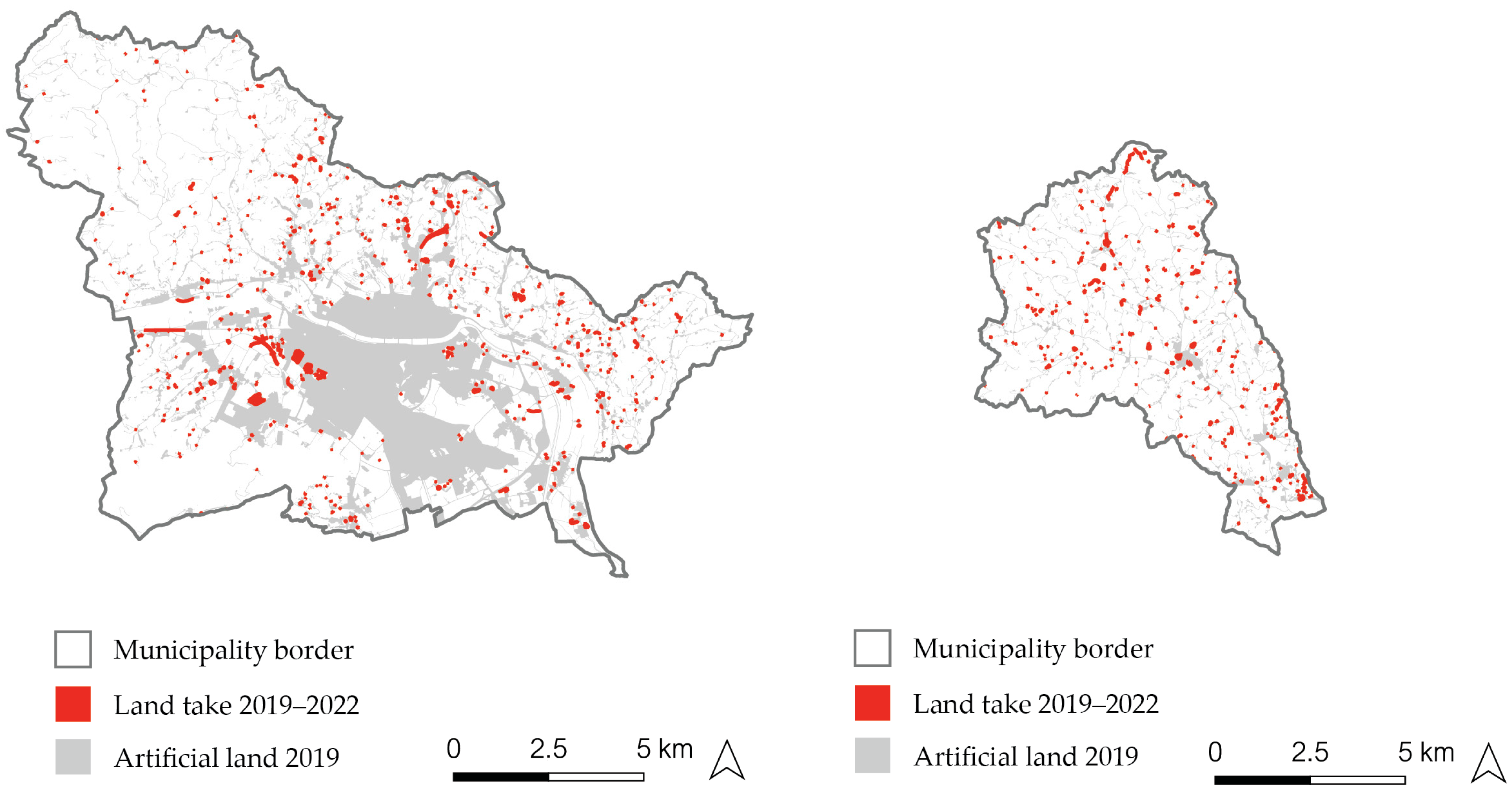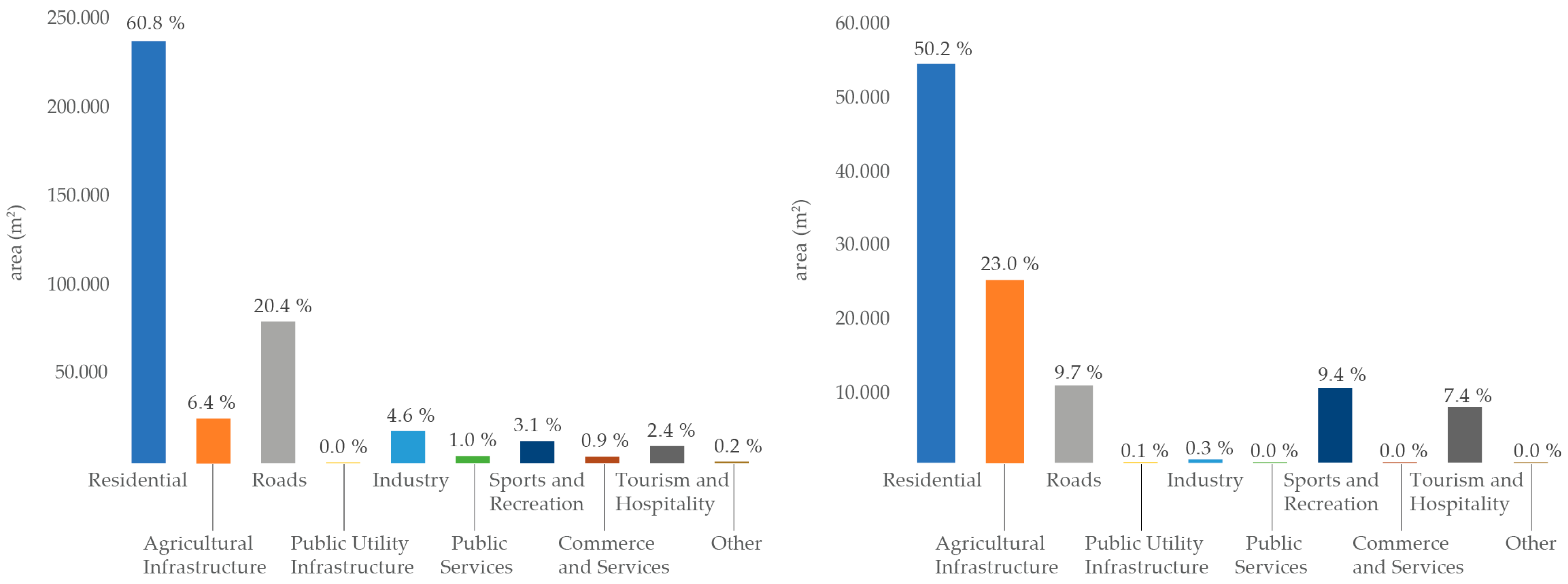A GIS-Based Approach to Land Take Monitoring and Actual Land Use Analysis
Abstract
1. Introduction
- The Roadmap to a Resource-Efficient Europe (European Commission, 2011) [4];
- The Seventh Environment Action Programme of the European Union until 2020 (Official Journal of the European Union, L 354/171, 2013) [5];
- The EU Soil Strategy for 2030 (European Commission, 2021) [6];
- The Eighth Environment Action Programme of the European Union until 2030 (Official Journal of the European Union, L 114/22, 2022) [7];
- The Proposal for a Directive on Soil Monitoring and Resilience (European Commission, 2023) [8].
1.1. Data Sources at European Level
- Detailed land cover and land use information for selected FUAs in Europe (for the reference years 2006, 2012 and 2018);
- Building height data for core urban areas in selected cities in Europe (for the reference year 2012);
- Street tree layer for each FUA (for the reference years 2012 and 2018) [16].
1.2. Data Sources of European Countries
1.3. Circular Spatial Management in Slovenia: A Path Toward Sustainable Land Use
- Spatial information infrastructure involves the establishment of comprehensive databases on building land, degraded areas and land take; linking legal land use data with the real estate cadastre; implementing a joint spatial intervention monitoring system; mandating the use of Building Information Modelling (BIM); and creating a registry of rental contracts and green space inventories for major cities;
- Spatial planning measures involve integrating circular principles into spatial planning guidelines, defining settlement and permanently protected agricultural zones, analyzing the potential of urban centres, drafting thematic action programmes (for housing, the economy, tourism, renewable energy), and preparing guidelines for soil unsealing;
- Land policy measures include the legal and cadastral restructuring of land parcels (land consolidation), the preparation of land supply plans on municipality level, the activation of degraded urban areas through contractual development, the establishment of land banks and the legal foundations for proactive land policy;
- Empowerment and promotion measures foresee the creation of an office or agency for circular spatial management, the establishment of expert working groups, training programmes for professionals and municipalities, and a dedicated web portal featuring information, good practices, and educational content on circular spatial management;
- Regulatory measures include the establishment of a special, public management system for business zones, with investment incentives conditional on compliance with circular spatial principles, and amendments to housing regulations aimed at revitalizing both the public and private rental markets and the existing housing stock;
- Economic and financial measures propose increased taxation of unused real estate, tax relief for rental income, reform of compensation fees for land use changes from agricultural to building land, and the establishment of a Circular Spatial Management Fund as a financial mechanism to support projects aligned with these principles.
1.4. Problem Definition and Study Objective
2. Materials and Methods
2.1. Location of the Study Areas
- The first step involved selecting an area based on the division of Slovenia into blocks covered by aerial imagery captured in the same year. A block from the northwest part of Slovenia was chosen, as it is covered by digital orthophoto imagery (DOF) for both 2019 and 2022.
- In the second step, the selected block was further refined using administrative boundaries. Within this block, the Podravska region was identified as the most suitable for analysis due to its diverse landscape, which includes both urban and rural characteristics.
- Since the entire Podravska region was too large for a detailed analysis, the third step involved selecting two study municipalities with distinct characteristics:
- a.
- Maribor, an urban municipality, representing a complex artificial environment with diverse spatial development patterns;
- b.
- Kungota, a rural municipality, allowing for the analysis of artificialization in rural environment.
2.2. The Problems of Data Availability
2.3. Data Sources
2.4. Data Processing and Methods
- Interpreter inconsistency in two consecutive captures;
- Misclassification of actual use.
2.4.1. GIS Procedure for Data Cleaning
- Criterion 1: Polygon area smaller than 25 m2.
- Criterion 2: Polygons with a P/A ratio greater than 1.5.
- Criterion 3: Polygon width smaller than 3 m.
- Criterion 4: Sharp polygons with a circle to polygon area ratio greater than 3.
- Removal of polygons smaller than 25 m2
- Removal of “slivers” based on perimeter-to-area ratio (P/A)
- Removal of “slivers” based on polygon width.
- Removal of polygons with sharp edges.
2.4.2. Manual Verification and Assignment of Land Use for Newly Artificialized Land
- If a polygon contains data on the actual use of building parts from the Real Estate Cadastre (GURS), the land use is assigned based on this data, as it reflects the most up-to-date situation.
- If the polygon lacks real estate cadastre data but is either fully or partially covered by a settled land polygon (MNVP), or lies within 2.5 m of one, land use is assigned based on settled land data. In such cases, polygons assigned land use based on proximity are subject to manual verification.
- If the polygon lacks data from the real estate cadastre (GURS) and settled land (MNVP), but overlaps with data on actual land use for public road and railway infrastructure (DRSI) and/or roads and railways from consolidated cadastre of economic public infrastructure (GURS), the land use is assigned as road and parking areas.
- Large surface polygons;
- Polygons assigned land use based on proximity to settled land polygon (MNVP);
- Polygons assigned land use based on public road and railway infrastructure (DRSI).
3. Results
3.1. Land Take in the Study Areas
3.2. Land Use Change Analysis
4. Discussion
5. Conclusions
Author Contributions
Funding
Data Availability Statement
Conflicts of Interest
Abbreviations
| CLC | Corine Land Cover |
| DRSI | Slovenian Infrastructure Agency |
| DOF | Digital Orthophoto |
| EU | European Union |
| GIS | Geographic Information System |
| GURS | Surveying and Mapping Authority of the Republic of Slovenia |
| MKGP | Ministry of Agriculture, Forestry and Food |
| MNVP | Ministry of Natural Resources and Spatial Planning |
| NNLT | No Net Land Take |
References
- European Environment Agency (EEA). Land Take and Net Land Take. Analysis and Data. Available online: https://www.eea.europa.eu/en/analysis/maps-and-charts/land-take-statistics-dashboards (accessed on 31 March 2025).
- Steffen, W.; Richardson, K.; Rockström, J.; Cornell, S.E.; Fetzer, I.; Bennett, E.M.; Biggs, R.; Carpenter, S.R.; de Vries, W.; de Witt, C.A.; et al. Planetary boundaries: Guiding human development on a changing planet. Science 2015, 347, 6223. [Google Scholar] [CrossRef] [PubMed]
- Korhonen, J.; Honkasalo, A.; Seppälä, J. Circular Economy: The Concept and its Limitations. Ecol. Econ. 2018, 143, 37–46. [Google Scholar] [CrossRef]
- European Commission (2011): Communication from the Commission to the European Parliament, the Council, the European Economic and Social Committee and the Committee of the Regions: Roadmap to a Resource Efficient Europe. Available online: https://eur-lex.europa.eu/legal-content/EN/ALL/?uri=CELEX%3A52011DC0571 (accessed on 31 March 2025).
- The Seventh Environment Action Programme of the European Union Until 2020 (Official Journal of the European Union, L 354/171, 2013). Available online: https://eur-lex.europa.eu/legal-content/EN/TXT/PDF/?uri=CELEX:32013D1386 (accessed on 2 April 2025).
- European Commission (2021): Communication from the Commission to the European Parliament, the Council, the European Economic and Social Committee and the Committee of the Regions: The EU Soil Strategy for 2030. Reaping the Benefits of Healthy Soil for People, Food, Nature and Climate. Available online: https://eur-lex.europa.eu/legal-content/EN/TXT/?uri=CELEX%3A52021DC0699 (accessed on 31 March 2025).
- The Eighth Environment Action Programme of the European Union Until 2030 (Official Journal of the European Union, L 114/22, 2022). Available online: https://eur-lex.europa.eu/legal-content/EN/TXT/HTML/?uri=CELEX:32022D0591 (accessed on 2 April 2025).
- European Commission (2023): Proposal for a Directive of the European Parliament and of the Council on Soil Monitoring and Resilience (Soil Monitoring Law). Available online: https://eur-lex.europa.eu/legal-content/EN/TXT/?uri=celex%3A52023PC0416 (accessed on 3 April 2025).
- Gensheimer, M.; Rossignol, M.; van Herwijnen, M.; Desjardins, X.; Devos, T.; Leclercq, A. Policy Brief. No Net Land Take Trajectories. Policies and Practices Across Europe; ESPON EGTS: Luxembourg, 2024; p. 20. Available online: https://www.espon.eu/sites/default/files/2024-12/no-net-land-take-trajectories_policy-brief.pdf (accessed on 12 March 2025).
- The Alpine Convention. Land Take in the Alpine Region: The Data Perspective. Summary. Available online: https://www.alpconv.org/fileadmin/user_upload/Organisation/TWB/SPSD/CDR_ACTS_IP_S3_1a_Land_Take_Data_Summary.pdf (accessed on 12 March 2025).
- Fina, S.; Hamacher, H.; Rönsch, J.; Scholz, B. Land Use Monitoring and Land Take in International Comparison: Methods and Data. Final Report; Umweltbundesamt: Dessau-Roßlau, Germany, 2023; p. 52. Available online: https://www.umweltbundesamt.de/en/publikationen/land-use-monitoring-land-take-in-international (accessed on 12 March 2025).
- LCplus Backbone 2021 (Raster 10 m), Europe, 3-Yearly. Available online: https://land.copernicus.eu/en/products/clc-backbone/clc-backbone-2021 (accessed on 20 May 2025).
- LCplus Backbone 2021 (Raster 10 m), Europe, 3-Yearly. Product User Manual. Available online: https://land.copernicus.eu/en/technical-library/product-user-manual-clc-backbone-2021/@@download/file (accessed on 20 May 2025).
- European Environmnet Agency: Net Land Take in Cities and Commuting Zones in Europe. Available online: https://www.eea.europa.eu/en/analysis/indicators/net-land-take-in-cities (accessed on 12 March 2025).
- Urban Atlas. Available online: https://www.eea.europa.eu/en/datahub/datahubitem-view/e006507d-15c8-49e6-959c-53b61facd873 (accessed on 12 March 2025).
- Urban Atlas. Available online: https://land.copernicus.eu/en/products/urban-atlas (accessed on 20 May 2025).
- D’Ascanio, R.; Desjardins, T.X.; Devos, T.; Dupont, V.; Estèbe, P.; Leclercq, A.; Palazzo, A.L.; Roose, T.A.; Sadowy, K.; Siedentop, S.; et al. No Net Land Take—Policies and Practices in European Regions. Main Administrative, Economic, Political or Social Challenger to Implement No Net Land Take (NNLT). Final Report; ESPON EGTC: Luxembourg, 2024; p. 88. Available online: https://www.espon.eu/sites/default/files/2024-06/no-net-land-take-policies-and-practices-in-european-regions-final-report.pdf (accessed on 12 March 2025).
- The Alpine Convention. Land Saving Targets in Alpine Countries: Status Quo and Challenges. Available online: https://www.alpconv.org/fileadmin/user_upload/Organisation/TWB/SPSD/CDR_ACTS_IP_SP1_3_Land_Saving_Targets.pdf (accessed on 12 March 2025).
- Environment Agency Austria. Umweltbundesamt. Flächenanspruchname. Available online: https://www.umweltbundesamt.at/umweltthemen/boden/flaecheninanspruchnahme/datengrundlage/fragen-und-antworten-zur-neuen-methodik (accessed on 12 March 2025).
- Portal GEO Slovenija. Sotočje Prostorskih Informacij. EUKN Policy Lab—Krožno Gospodarjenje S Prostorom—GRADIVO. Available online: https://www.geo-slovenija.si/blog/eukn-policy-lab-krozno-gospodarjenje-s-prostorom-gradivo (accessed on 12 March 2025).
- Spatial Management Act. Zakon O Urejanju Prostora (ZUreP-3). Available online: https://pisrs.si/pregledPredpisa?id=ZAKO8249 (accessed on 6 April 2025).
- Lacoere, P.; Decoville, A.; Delattre, R.; Melot, R.; Grimski, D.; Schamann, M.; Halleux, J.-M. National introduction of no net land take: A comparative study of five pioneering countries seeking to limit their land consumption. Town Plan. Rev. 2024, 96, 4. [Google Scholar] [CrossRef]
- European Environment Agency (EEA). Corine Land Cover Accounting Layer. Available online: https://www.eea.europa.eu/en/datahub/datahubitem-view/a55d9224-a326-4cb1-9b9c-3a324520341a (accessed on 7 April 2025).
- Marquard, E.; Bartke, S.; Gifreu i Font, J.; Humer, A.; Jonkman, A.; Jürgenson, E.; Marot, N.; Poelmans, L.; Repe, B.; Rybski, R.; et al. Land consumption and land take: Enhancing conceptual clarity for evaluating spatial governance in the EU context. Sustainability 2020, 12, 8269. [Google Scholar] [CrossRef]
- Decoville, A.; Schneider, M. Can the 2050 zero land take objective of the EU be reliably monitored? A comparative study. J. Land Use Sci. 2016, 11, 331–349. [Google Scholar] [CrossRef]
- Desrousseaux, M.; Schmitt, B.; Billet, P.; Béchet, B.; Le Bissonnais, Y.; Ruas, A. Artificialised land and land take: What policies will limit its expansion and/or reduce its impacts? In International Yearbook of Soil Law and Policy 2018, 1st ed.; Ginzky, H., Dooley, E., Heuser, I.L., Kasimbazi, E., Markus, T., Qin, T., Eds.; Springer Nature: Cham, Switzerland, 2019; pp. 149–165. [Google Scholar]
- Nicolau, R.; David, J.; Caetano, M.; Pereira, J.M.C. Ratio of Land Consumption Rate to Population Growth Rate-Analysis of Dierent Formulations Applied to Mainland Portugal. ISPRS Int. J. Geo-Inf. 2019, 8, 10. [Google Scholar] [CrossRef]
- BIO by Deloitte. Study Supporting Potential Land and Soil Targets Under the 2015 Land Communication; Report Prepared for the European Commission, DG Environment in Collaboration with AMEC, IVM and WU; Publications Office of the European Union: Luxembourg, 2014; p. 464. [Google Scholar]
- Slovenian Environment Agency. Environmental Indicators in Slovenia. Land Take. Soil and Land Take. Land Take. Available online: https://kazalci.arso.gov.si/en/content/land-take-0 (accessed on 6 April 2025).
- Spatial Information System of Republic of Slovenia. The Register of a Building Land. Available online: https://pis.eprostor.gov.si/en/pis/evidenca-stavbnih-zemljisc.html?changeLang=true (accessed on 6 April 2025).
- Bizjak, I.; Cotič, B.; Gantar, D.; Gulič, A.; Koblar, S.; Kozamernik, J.; Mušič, B.; Mujkić, S.; Nikšič, M.; Sendi, R.; et al. Poročilo o prostorskem razvoju 2021 [Spatial Development Report 2021]; Ministrstvo za okolje in prostor, Direktorat za prostor, graditev in stanovanja: Ljubljana, Slovenia, 2021; p. 117. Available online: https://www.gov.si/assets/ministrstva/MNVP/Dokumenti/Prostorski-razvoj/porocilo_prostorski_razvoj_2021.pdf (accessed on 6 April 2025).
- Statistical Office of the Republic of Slovenia. SISTAT Database. Available online: https://pxweb.stat.si/SiStat/en (accessed on 6 June 2025).
- Surveying and Mapping Authority of the Republic of Slovenia. Report on the Slovenian Real Estate Market for the Year 2022. March 2023. Available online: https://www.e-prostor.gov.si/podrocja/trg-in-vrednosti-nepremicnin/trg-nepremicnin/?acitem=1967-2268 (accessed on 5 June 2025).
- Bartol, B.; Humerca Šolar, L.; Lupše, I.; Miklavčič, T.; Torbica, J. Spatial Development Strategy of Slovenia 2050; Ministry of Natural Resources and Spatial Planning: Ljubljana, Slovenia, 2024; p. 99. Available online: https://www.gov.si/assets/ministrstva/MNVP/Dokumenti/Prostorski-razvoj/SPRS/Strategija-prostorskega-razvoja_2050_v-angleskem-jeziku.pdf (accessed on 7 June 2025).





| Data | Source | Purpose of Use |
|---|---|---|
| Actual land use of agricultural and forest land | Ministry of Agriculture, Forestry and Food (MKGP). | Monitoring of artificial land in 2019 and 2022 for land take calculation between the two years |
| Actual land use of settled land | Ministry of Natural Resources and Spatial Planning (MNVP) | Assigning actual land use to newly artificialized land (land take) |
| Actual use of building parts—real estate cadastre | Surveying and mapping authority of the Republic of Slovenia (GURS) | Assigning actual land use to newly artificialized land (land take) |
| Actual land use for public road and railway infrastructure | Slovenian Infrastructure Agency (DRSI) | Assigning actual land use to newly artificialized land (land take) |
| Roads and railways from consolidated cadastre of economic public infrastructure (ZKGJI) | Surveying and mapping authority of the Republic of Slovenia (GURS) | Assigning actual land use to newly artificialized land (land take) |
| Orthophoto | Surveying and mapping authority of the Republic of Slovenia (GURS) | Visual interpretation and manual verification of land use changes. |
| Land Take | Podravska Region | Municipality of Maribor | Municipality of Kungota | |||
|---|---|---|---|---|---|---|
| Area (Share) | No. of Polygons (Share) | Area (Share) | No. of Polygons (Share) | Area (Share) | No. of Polygons (Share) | |
| POTENTIAL LAND TAKE | 559.25 ha (100%) | 53,544 (100%) | 52.64 ha (100%) | 3,799 (100%) | 17.25 ha (100%) | 2,156 (100%) |
| Land take excluded by GIS procedure | 64.40 ha (11.5%) | 41,234 (77.0%) | 3.15 ha (6.0%) | 2,906 (76.5%) | 0.80 ha (4.6%) | 1385 (64.2%) |
| REMAINING LAND TAKE | 494.85 ha (88.5%) | 12,310 (23.0%) | 49.49 ha (94.0%) | 893 (23.5%) | 16.45 ha (95.4%) | 771 (35.8%) |
| Land take excluded after manual verification | / | / | 10.46 ha (21.1%) | 335 (37.5%) | 5.70 ha (34.6%) | 467 (60.6%) |
| LAND TAKE 2019–2022 | / | / | 39.03 ha (78.9%) | 558 (62.5%) | 10.75 ha (65.4%) | 304 (39.4%) |
| Data Source | Corine Land Cover | National Data (MKGP) | ||
|---|---|---|---|---|
| Subject of observation | Land take | Land take | Land take | Land take |
| Period of observation | 2012–2018 | 2012–2019 | 2015–2022 | 2019–2022 |
| Measurement unit | m2/year·km2 | m2/year·km2 | m2/year·km2 | m2/year·km2 |
| Slovenia (external sources) | 52.78 [1] | 279.50 [29] | 310.79 [20] | |
| Municipality Maribor (original research) | 881.96 | |||
| Municipality Kungota (original research) | 731.31 | |||
Disclaimer/Publisher’s Note: The statements, opinions and data contained in all publications are solely those of the individual author(s) and contributor(s) and not of MDPI and/or the editor(s). MDPI and/or the editor(s) disclaim responsibility for any injury to people or property resulting from any ideas, methods, instructions or products referred to in the content. |
© 2025 by the authors. Licensee MDPI, Basel, Switzerland. This article is an open access article distributed under the terms and conditions of the Creative Commons Attribution (CC BY) license (https://creativecommons.org/licenses/by/4.0/).
Share and Cite
Lamovec, P.; Kuk, K.; Černič, B.; Černe, T.; Lupše, I. A GIS-Based Approach to Land Take Monitoring and Actual Land Use Analysis. Land 2025, 14, 1322. https://doi.org/10.3390/land14071322
Lamovec P, Kuk K, Černič B, Černe T, Lupše I. A GIS-Based Approach to Land Take Monitoring and Actual Land Use Analysis. Land. 2025; 14(7):1322. https://doi.org/10.3390/land14071322
Chicago/Turabian StyleLamovec, Peter, Katarina Kuk, Barbara Černič, Tomaž Černe, and Ines Lupše. 2025. "A GIS-Based Approach to Land Take Monitoring and Actual Land Use Analysis" Land 14, no. 7: 1322. https://doi.org/10.3390/land14071322
APA StyleLamovec, P., Kuk, K., Černič, B., Černe, T., & Lupše, I. (2025). A GIS-Based Approach to Land Take Monitoring and Actual Land Use Analysis. Land, 14(7), 1322. https://doi.org/10.3390/land14071322





